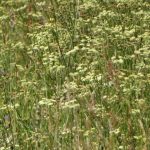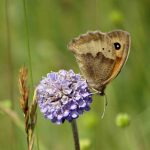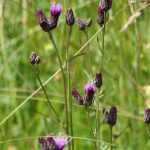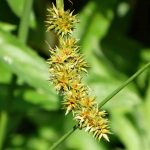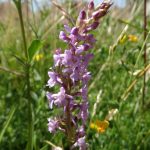Sally Rankin organised a visit to two of BBOWT’s Oxfordshire meadow reserves on Sunday 24 June. The group were pleased to be joined by Camilla Lambrick, an expert on the flora of Oxfordshire. The first destination was Asham Meads Reserve, which lies to the north-east of Otmoor in the Ray valley. The meadows were once ploughed and the old ridge and furrow profile can still be seen. In the first field, the top of the vegetation had a wavy silhouette against the darker hedge on the far side of the field, but, counterintuitively, the higher parts were the tall Tufted Hair-grass in the furrows, while the lower parts were the ridges. The meadow had a carpet of flowers, including the rayed form of Common Knapweed, Red Clover and yellow Common Bird’s-foot-trefoil, Lesser Spearwort and Yellow-rattle. In some parts, the ridges were pale yellow with Pepper-saxifrage, while in others they were bright yellow with Lady’s Bedstraw. Grasshoppers kept up a constant background churring, Yellowhammer, Whitethroat, Skylark, Raven and Bullfinch were heard and butterflies were abundant, particularly Meadow Brown and Marbled White, together with lower numbers of Common Blue, Large Skipper and Small Tortoiseshell. False Fox-sedge, with a long bract below the ginger-coloured inflorescence, was inspected carefully here before heading into The Spinney, where there are a few clumps of the nationally scarce True Fox-sedge. The route then led along the edge of Upper Marsh field, where Devil’s-bit Scabious was in flower. In other habitats, this plant usually flowers later in the year, but this seems to be a special adaptation to flower before the hay is cut. The next field, Rowbottom, had a particularly rich assemblage of plants, including Great Burnet, Saw-wort, Dropwort, Meadowsweet, Fairy Flax, Meadow Thistle, Dyer’s Creenweed, Sneezewort, Betony, Ragged-Robiin, Quaking Grass and Marsh Ragwort. Then while most of the group were enjoying a picnic lunch back at the car park, one eagle-eyed member found a number of plants of True Fox-sedge in a nearby ditch, a new record for Oxfordshire of this very rare plant.
In the afternoon, the group drove to Wendlebury, before a hot walk in to BBOWT’s Woodsides Reserve, another ancient hay meadow. Common Meadow-rue, Spiny Rest-harrow, Common Milkwort and Fragrant-orchid were amongst the flowers which had not been seen in the morning and Meadow Thistle was more abundant than at Asham Meads. A Roe Deer bounded across the meadow. The ridges were wider than at Asham Meads, and the ridge and furrow system showed the S-shaped curve at the field edge that was typical of ploughing with a team of oxen, indicating that this was an older field system. The margin in the adjacent arable field had a number of interesting plants, including both Round-leaved and Sharp-leaved Fluellen.
Pictures by Laurie Haseler

